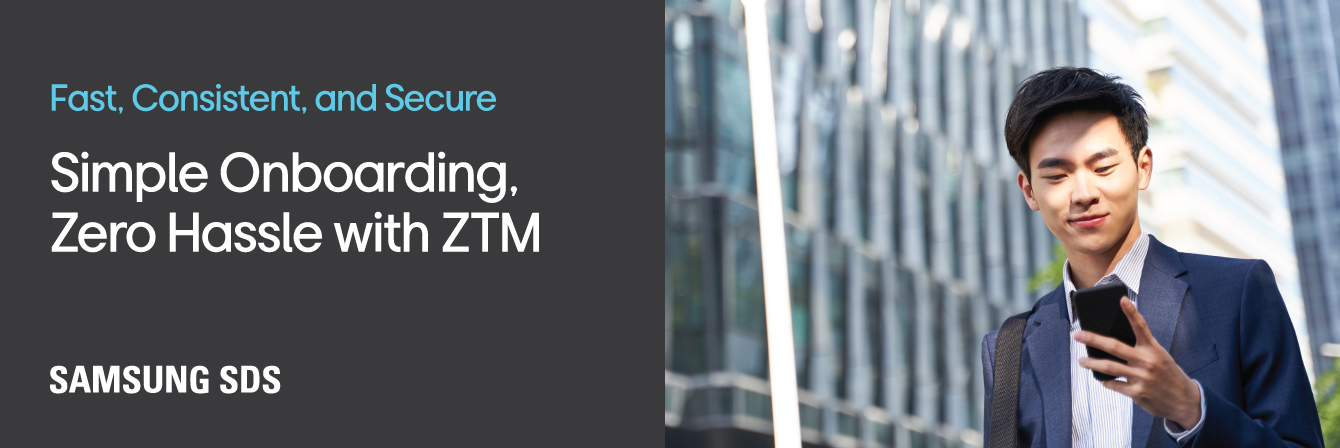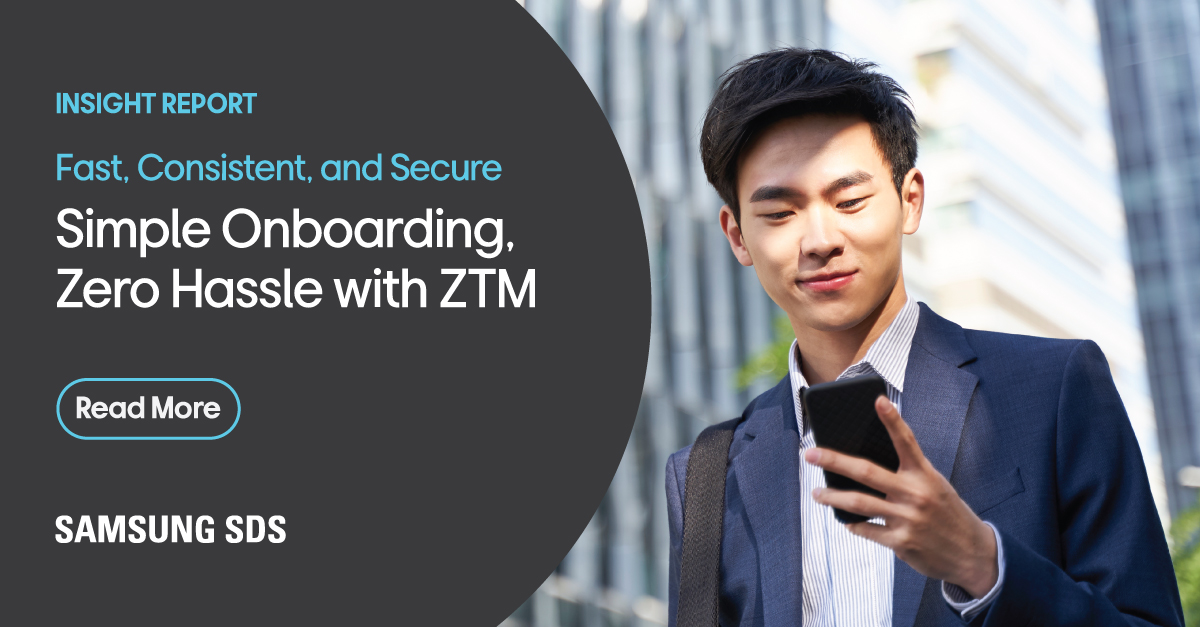
With next-generation mobile management solutions now available, companies are leaving behind siloed, inefficient processes in favor of integrated, automated workflows.
Zero-touch onboarding allows organizations to streamline the setup and deployment of mobile devices. Compared to legacy systems that require manual configuration, it offers faster deployment, greater consistency, lower costs, improved IT efficiency, and enhanced security.
Interested to learn more about how next-generation zero-touch onboarding can serve your company? Read on as we’ll cover the zero-touch onboarding’s functions, advantages, and how-to best practices.
Why Organizations Adopt Zero Touch Onboarding: 3 Advantages
“The Samsung SDS Zero Touch Mobility solution will allow us to harness the data of our mobile fleet, streamline the process, and save costs — so we can deliver fast and stay agile,” says Evan Tomlin, Chief Technology Officer of Hyperion Partners.
Even beyond information-harnessing, process-streamlining, and cost-saving, our zero touch onboarding solution yields scalability, improves the employee experience, and enhances regulatory compliance — here’s a look into how.
Increased Efficiency and Scalability
Zero-touch onboarding enhances efficiency by automating the initial setup and deployment of mobile devices across the whole organization. This automation prepares devices for immediate use upon receipt, requiring minimal intervention from end users or IT staff. Organizations then speed up deployment and ensure a consistent setup across all devices, helping to reduce errors and inconsistencies that can come from manual configurations.
Furthermore, the adaptability of zero-touch onboarding systems supports organizational growth. As companies expand, the ability to integrate and deploy an increasing number of devices without additional human resources supports ongoing operations. This adaptability extends to managing various device types across different operating systems, ensuring consistent and secure management — no matter the device specifications.
In a similar vein, integrated ZTM tools for analytics and reporting provide real-time insights into device performance and usage, enabling proactive management and informed decision-making that further enhances efficiency.
Improved Employee Experience
New employees have a lot to think about during their induction and critical onboarding period, and Zero Touch Mobility (ZTM) ensures that mobile configuration issues are not on their list of concerns.
Zero-touch onboarding transforms the employee experience by ensuring that all devices are configured and ready to use from the first day of employment. This means employees spend less time dealing with setup issues and more time engaging with their core responsibilities. By eliminating the need for extensive IT interactions for basic setup tasks, employees gain autonomy in managing their devices — making a traditionally complex matter simple.
Zero-touch onboarding’s standardized processes also mean that all employees, regardless of location or department, have the same user experience. This uniformity is particularly valuable in large organizations with dispersed teams, ensuring that every team member has equally streamlined access to technology resources.
Enhanced Security and Compliance
Zero-touch onboarding enhances security by ensuring that devices are configured according to company policies from the outset. This standardization minimizes the risk of human error in device setups, which can, and commonly does, lead to security vulnerabilities.
Similarly, automated configurations ensure uniform application of all security protocols, while automatic updates help maintain robust security measures consistently across all devices — both of which reduce potential security breaches and simplify ongoing compliance monitoring.
Moreover, the automation of deployment processes comes with a comprehensive and transparent audit trail for each device, facilitating adherence to both internal standards and industry regulations. In the case of Samsung ZTM, the system enables organizations to track and manage device configurations and compliance statuses within a single framework. Practically, this allows for quick adjustments to security policies and configurations as needed, ensuring that all devices remain compliant with evolving security requirements.
Samsung ZTM's centralized control simplifies the management of a mobile fleet, enabling IT departments to implement security measures and track compliance across all devices more effectively.
5 How-Tos: The Components of Successful Zero-Touch Onboarding
Implementing zero-touch onboarding involves a series of strategic steps to ensure the successful deployment and management of mobile devices within an organization. Here are the key components that contribute to an effective zero-touch onboarding strategy.
1.Integration with an Enterprise Mobility Management Platform
For zero-touch onboarding to operate effectively, it should be integrated with an enterprise mobility management platform. This platform serves as the central hub for managing all devices and should be compatible with existing IT infrastructure to support various device types and operating systems — facilitating streamlined management across the organization.
2. Automated Workflow Configuration
Setting up automated workflows minimizes manual intervention and errors. These workflows should encompass all aspects of device management, from the initial setup and enrollment to ongoing maintenance and eventual decommissioning. Automation standardizes processes and ensures consistent device configuration in line with organizational policies and security standards.
3. Comprehensive Security Protocols
Security measures are a foundational element of zero-touch onboarding — involving setting up automatic device encryption, secure access controls, and continuous monitoring systems. Centrally managing updates and patches and pushing them automatically keeps devices secure against emerging threats. Establishing guidelines for data handling and storage on these devices also supports compliance with regulatory standards.
4. Training and Support
Although zero-touch onboarding reduces the need for hands-on support, IT staff should still be trained on the ZTM systems and procedures — helping them to effectively manage and troubleshoot the automated processes. Additionally, end-users should receive guidance on how to use their new devices in alignment with company policies.
5. Analytics and Monitoring Tools
Utilizing analytics and monitoring tools is an integral part of managing and refining zero-touch onboarding processes. These tools track device performance, user interactions, and compliance with IT policies, among other key metrics. The insights gained from these tools enable mobile or IT administrators to proactively manage the device fleet, anticipate needs, and resolve issues before they impact the business. Moreover, regular analysis of this data helps organizations optimize their mobile device management strategies, making adjustments based on non-abstract, real-world usage and performance trends.
Enhanced Mobile Management with Samsung Zero-Touch Onboarding
The Samsung zero-touch onboarding solution streamlines mobile device management, enabling your organization to deploy, configure, and maintain your mobile fleets with next-generation ease and efficiency.
By automating and optimizing the entire lifecycle of mobile devices, from initial setup to eventual decommissioning, our solution increases efficiency, maximizes productivity, and ensures a seamless end-user experience.
Learn more about Samsung SDS Zero Touch Mobility, or get in touch with one of our team members today.
Contact Our Experts
- 5 Mobile Lifecycle Management Best Practices | Samsung SDS
- Addressing Common Mobile Management Challenges | Samsung SDS
- Hidden Costs of Poor Enterprise Device Management | Samsung SDS
- What's New in Zero Touch Mobility 24.08
- The Benefits of ZTM for Managed Service Providers - MSPs
- What's New in Zero Touch Mobility 24.06
